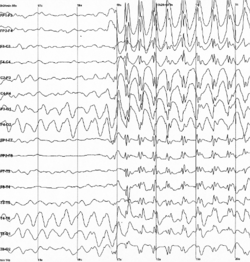Seizure: Difference between revisions
>David Hedlund ===External links=== * [https://en.wikipedia.org/wiki/Epileptic_seizure Epileptic seizure (Wikipedia)] |
>Josikins overhauling effect components as part of SEI improvement project |
||
| Line 1: | Line 1: | ||
<onlyinclude>[[File:Spike-waves.png|250px|thumbnail|right|Generalized 3 Hz spike and wave discharges in EEG during a seizure]] | <onlyinclude>[[File:Spike-waves.png|250px|thumbnail|right|Generalized 3 Hz spike and wave discharges in EEG during a seizure]] | ||
An '''epileptic seizure''' (colloquially a '''fit''') | An '''epileptic seizure''' (colloquially a '''fit''') can be described as a brief episode of signs and/or symptoms which are due to abnormal, excessive, or synchronous neuronal activity in the brain.<ref>Epileptic seizures and epilepsy: definitions proposed by the International League Against Epilepsy (ILAE) and the International Bureau for Epilepsy (IBE) (PubMed.gov / NCBI) | http://www.ncbi.nlm.nih.gov/pubmed/15816939</ref> The outward effect can vary from uncontrolled jerking movement (tonic-clonic seizure) to as subtle as a momentary loss of awareness (absence seizure). | ||
The following list contains a more comprehensive set of symptoms: | |||
*losing consciousness and then exhibiting confusion afterwards | |||
*having uncontrollable muscle spasms which often result in falling | |||
*drooling or frothing at the mouth | |||
*jaw clenching and tongue biting | |||
*having sudden, rapid eye movements | |||
*making unusual noises, such as grunting | |||
*losing control of bladder or bowel function | |||
The disease of the brain characterized by an enduring predisposition to generate epileptic seizures is known as epilepsy,<ref>Epileptic seizures and epilepsy: definitions proposed by the International League Against Epilepsy (ILAE) and the International Bureau for Epilepsy (IBE) (PubMed.gov / NCBI) | http://www.ncbi.nlm.nih.gov/pubmed/15816939</ref><ref>ILAE official report: a practical clinical definition of epilepsy (PubMed.gov / NCBI) | http://www.ncbi.nlm.nih.gov/pubmed/24730690</ref> but seizures can also occur in people who do not have epilepsy. Depending on the cause, epilepsy is generally treated with [[seizure suppression|anticonvulsant]] drugs such as [[diazepam]] and [[pregabalin]]. | |||
Seizures are most commonly induced under the influence of [[Substance withdrawal|withdrawals]] from prolonged chronic [[benzodiazepine]] or [[alcohol]] usage. However they can also occur under the influence of [[dosage#heavy|moderate]] [[dosage|dosages]] of [[stimulant|stimulants]], certain [[opioid|opiiods]], [[Synthetic cannabinoid|synthetic cannabinoids]] and the [[25x-NBOMe]] series of [[psychedelic|psychedelics]].</onlyinclude> | |||
===See also=== | ===See also=== | ||
*[[Responsible use]] | *[[Responsible use]] | ||
Revision as of 05:03, 16 March 2018

An epileptic seizure (colloquially a fit) can be described as a brief episode of signs and/or symptoms which are due to abnormal, excessive, or synchronous neuronal activity in the brain.[1] The outward effect can vary from uncontrolled jerking movement (tonic-clonic seizure) to as subtle as a momentary loss of awareness (absence seizure).
The following list contains a more comprehensive set of symptoms:
- losing consciousness and then exhibiting confusion afterwards
- having uncontrollable muscle spasms which often result in falling
- drooling or frothing at the mouth
- jaw clenching and tongue biting
- having sudden, rapid eye movements
- making unusual noises, such as grunting
- losing control of bladder or bowel function
The disease of the brain characterized by an enduring predisposition to generate epileptic seizures is known as epilepsy,[2][3] but seizures can also occur in people who do not have epilepsy. Depending on the cause, epilepsy is generally treated with anticonvulsant drugs such as diazepam and pregabalin.
Seizures are most commonly induced under the influence of withdrawals from prolonged chronic benzodiazepine or alcohol usage. However they can also occur under the influence of moderate dosages of stimulants, certain opiiods, synthetic cannabinoids and the 25x-NBOMe series of psychedelics.
See also
- Responsible use
- Subjective effects index
- Psychedelics - Subjective effects
- Dissociatives - Subjective effects
- Deliriants - Subjective effects
External links
References
- ↑ Epileptic seizures and epilepsy: definitions proposed by the International League Against Epilepsy (ILAE) and the International Bureau for Epilepsy (IBE) (PubMed.gov / NCBI) | http://www.ncbi.nlm.nih.gov/pubmed/15816939
- ↑ Epileptic seizures and epilepsy: definitions proposed by the International League Against Epilepsy (ILAE) and the International Bureau for Epilepsy (IBE) (PubMed.gov / NCBI) | http://www.ncbi.nlm.nih.gov/pubmed/15816939
- ↑ ILAE official report: a practical clinical definition of epilepsy (PubMed.gov / NCBI) | http://www.ncbi.nlm.nih.gov/pubmed/24730690
